Pearson biology chapter 4 - Study guides, Class notes & Summaries
Looking for the best study guides, study notes and summaries about Pearson biology chapter 4? On this page you'll find 19 study documents about Pearson biology chapter 4.
All 19 results
Sort by
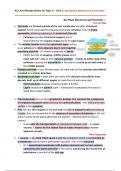 Popular
Popular
-
Unit 2 Summary Edexcel International A Level Biology - Chapter 4
- Summary • 15 pages • 2024
-
Available in package deal
-
- $8.19
- 1x sold
- + learn more
Concise and coloured notes for Pearson Edexcel's International A Level Biology sat in January, June or October. This document follows the IAL specification and textbook order, covering all the topics in Unit 2, specifically Chapter 4: Development, Biodiversity & Conservation.
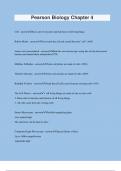
-
Pearson Biology Chapter 4
- Exam (elaborations) • 5 pages • 2024
-
- $10.49
- + learn more
Pearson Biology Chapter 4 Cell - answerBasic unit of structure and function of all living things Robert Hooke - answerDiscovered the cell and coined the term "cell" (1665) Anton van Leeuwenhoek - answerMade his own microscope, using this tool he discovered bacteria and named them animalcules(1974) Matthias Schleiden - answerNotices all plants are made of cells (1838) Theodor Schwann - answerNotices all animals are made of cells (1839) Rudolph Virchow - answerFound that all cells come fr...
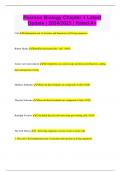
-
Pearson Biology Chapter 4 Latest Update | 2024/2025 | Rated A+
- Exam (elaborations) • 7 pages • 2024
-
- $10.32
- + learn more
Pearson Biology Chapter 4 Latest Update | 2024/2025 | Rated A+ Cell Fundamental unit of structure and function in all living organisms Robert Hooke Identified and named the "cell" (1665) Anton van Leeuwenhoek Developed his own microscope and discovered bacteria, calling them animalcules (1674) Matthias Schleiden Observed that all plants are composed of cells (1838) Theodor Schwann Observed that all animals are composed of cells (1839) Rudolph Virchow Concluded that all cells arise from...

-
Test Bank Biopsychology (10th Edition) by John P. J. Pinel
- Exam (elaborations) • 1304 pages • 2024
-
- $17.99
- + learn more
Biopsychology 10th Edition by Pinel Test Bank Stuvia Is Available For Download After Purchase. In Case You Encounter Any Difficulties with Download or want the document in a Different Format, Please Feel Free to Contact Me via Inbox. I Will Promptly Sort You. Thank You Test Bank Biopsychology (10th Edition) by John P. J. Pinel is your essential study companion for mastering biological psychology. You'll find comprehensive exam questions and practice tests covering brain and behavior ...
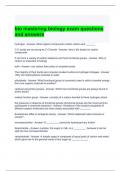
-
Mastering Biology Exam Bundle
- Package deal • 33 items • 2024
-
- $40.49
- + learn more
1 Exam (elaborations) Unit 1 Mastering Biology Exam Questions and Answers 2 Exam (elaborations) Pearson Mastering Biology Chapter 1 Exam Questions and Answers 3 Exam (elaborations) MyLab and Mastering Biology Chapter 1 and 2 Exam Questions and Answers 4 Exam (elaborations) Mastering Biology Unit 2 Exam Questions and Answers 5 Exam (elaborations
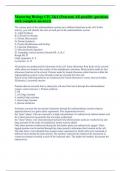
-
Mastering Biology-Exam (A+ GRADED) Combined questions with 100% correct answers
- Package deal • 8 items • 2023
-
- $42.99
- + learn more
Mastering Biology (Test questions with 100% correct answers) Chapter 1-3 Mastering Biology (Practice questions with 100% correct answers) Mastering Biology CH. 3&4 (Pearson) All possible questions with complete answers)
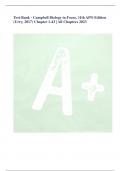
-
Test-Bank - Campbell Biology in Focus, 11th AP® Edition (Urry, 2017) Chapter 1-43 | All Chapters 2023
- Exam (elaborations) • 1244 pages • 2023
- Available in package deal
-
- $12.99
- + learn more
Test-Bank - Campbell Biology in Focus, 11th AP® Edition (Urry, 2017) Chapter 1-43 | All Chapters 2023 Test Bank Campbell Biology, 11e (Urry) Chapter 1 Evolution, the Themes of Biology, and Scientific Inquiry 1.1 Multiple-Choice Questions 1) Cells are . A) only found in pairs, because single cells cannot exist independently B) limited in size to 200 and 500 micrometers in diameter C) characteristic of eukaryotic but not prokaryotic organisms D) characteristic of prokaryotic and eukaryo...
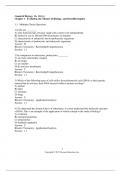
-
Test Bank Campbell Biology, 11th edition by Urry Cain
- Exam (elaborations) • 1242 pages • 2023
-
- $12.99
- + learn more
Campbell Biology, 11e (Urry) Chapter 1 Evolution, the Themes of Biology, and Scientific Inquiry 1.1 Multiple-Choice Questions 1) Cells are ________. A) only found in pairs, because single cells cannot exist independently B) limited in size to 200 and 500 micrometers in diameter C) characteristic of eukaryotic but not prokaryotic organisms D) characteristic of prokaryotic and eukaryotic organisms Answer: D Bloom's Taxonomy: Knowledge/Comprehension Section: 1.1 2) In comparison to euka...

-
Test Bank For Journey of Adulthood 8th Edition By Bjorklund
- Exam (elaborations) • 222 pages • 2023
-
Available in package deal
-
- $33.74
- + learn more
CHAPTER 1 INTRODUCTION TO ADULT DEVELOPMENT CHAPTER OUTLINE • Basic Concepts in Adult Development • Sources of Change o NormativeAge-GradedInfluences o Biology 0 Biological Clock o SharedExperiences 0 Social Clock 0 Ageism o InternalChangeProcesses o NormativeHistory-GradedInfluences 0 Culture o NonnormativeLifeEvents • Sources of Stability o Genetics 0 Behavior Genetics 0 Twin Studies o Environment o InteractionistView 0 Epigenetic inheritance • A Word about “A...
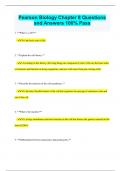
-
Pearson Biology Chapter 8 Questions and Answers 100% Pass
- Exam (elaborations) • 7 pages • 2024
-
- $10.52
- + learn more
Pearson Biology Chapter 8 Questions and Answers 100% Pass 1. **What is a cell?** - It's the basic unit of life. 2. **Explain the cell theory.** - According to this theory, all living things are composed of cells. Cells are the basic units of structure and function in living organisms, and new cells arise from pre-existing cells. 3. **Describe the function of the cell membrane.** - It's the thin, flexible barrier of the cell that regulates the passage of substances into and out of t...

Did you know that on average a seller on Stuvia earns $82 per month selling study resources? Hmm, hint, hint. Discover all about earning on Stuvia


